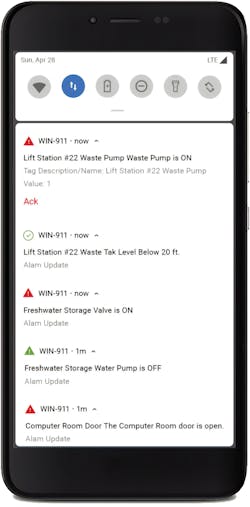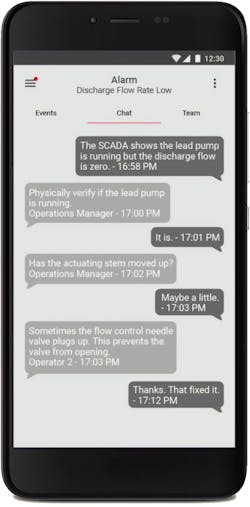Millions of dollars are invested each year in capital improvements to facilities and equipment to increase product safety, protect employees and reduce costs, which is important since equipment in a typical food processing plant may run 16 to 20 hours a day, every day. Often, equipment failure is the most common cause for downtime. The longer it takes plant personnel to respond and repair equipment, the more damaging the interruption. What’s more, systems that are not at full speed create a domino effect that can result in missed deadlines, lost revenues and disappointed customers.
Unplanned downtime can cost a food processing facility an astounding $30,000 per hour.[1] Additionally, according to analyst firm Aberdeen Research, 82% of companies have experienced unplanned downtime over the past three years[2], and a Deloitte industry report cited recent studies that show unplanned downtime costs industrial manufacturers an estimated $50 billion annually[3]. However, downtime can cost a company more than just money — it can be a logistical nightmare. The expenses and ramifications are simply too high for plants to risk equipment failures, particularly now.
As the world grapples with the effects of the COVID-19 pandemic, the food processing industry is under more pressure than ever to maintain ongoing operations. In the United States, food processing plants have been deemed essential, and state and federal authorities are working to keep supply lines intact. However, given that maintenance worker shortages existed even before the pandemic, what can plants do to mitigate unplanned downtime? Let’s explore the issues and solutions that can help you navigate these challenges.
Worker shortage and plant downtime
U.S. manufacturing is in the thick of an expected shortage of two million workers over 2015–2025, according to a report from Deloitte and the Manufacturing Institute.[4] A 2017 industry study sponsored by Advanced Technology Services found that the leading cause of unscheduled downtime within respondents’ facilities was aging equipment (42 percent), followed by operator error (19 percent) and lack of time needed to perform necessary maintenance (13 percent)[5].
Of all the core disciplines affected by the shortage of trained personnel, machine maintenance may be the most troublesome for food and beverage processors. Thirty-five percent of U.S. manufacturers are currently seeking maintenance technicians, and an even higher percentage are shifting at least some maintenance responsibilities to operating personnel — a dangerous tactic at a time when equipment is becoming increasingly automated and complex.[6]
One strategy to help resolve this is for food processing plants to invest in technology for areas with worker shortages, such as sensors that monitor whether a machine is working properly instead of having someone possibly crawl under equipment to check out a problem. Another way is through the use of remote alarm notification software, which allows fewer people to monitor many more assets using devices that people already have, such as smartphones and tablets. Uninterrupted remote availability is essential to ensure that systems can be continuously monitored, even without staff onsite or with fewer people working at the facility.
Remote alarm notification
Hardware and software are available that can constantly monitor equipment and, by applying machine learning to historical data, warn when a breakdown or other problem is imminent. Bolstered by wireless technology and the Industrial Internet of Things (IIoT), these customizable systems have the potential to bring predictive maintenance to a new level.
The benefits of utilizing a remote monitoring and notification software system via a mobile app include:
- Streamlines decision making. Push notifications let you quickly see what is wrong, send an acknowledgment, and monitor alarm condition changes in real-time, right from your smartphone.
- Promotes team problem solving. Chat helps your entire team converse, brainstorm and share solutions on-the-fly, from wherever they are — whether in the plant, at home or on the road.
- Work more efficiently. Team visibility shows you who has seen an alarm as well as who has acknowledged it, reducing guesswork and redundant responses.
- Multiple communication channel support. Ensuring resiliency through voice notification and SMS messaging in the event of internet connectivity issues.
Conclusion
Food processors play an essential world-wide role in helping to ensure short- and long-term food security. Through the installation of remote alarm notification software, food processing plants can move from reactive to a more controlled, predictive maintenance approach.
[1] https://www.wipfli.com/insights/blogs/manufacturing-tomorrow-blog/170628---the-real-cost-of-unplanned-downtime (accessed January 16, 2020).
[2] https://www.aberdeen.com/techpro-essentials/stat-of-the-week-the-rising-cost-of-downtime/ (accessed September 2, 2020).
[3] https://www2.deloitte.com/uk/en/insights/focus/industry-4-0/using-predictive-technologies-for-asset-maintenance.html (accessed September 2, 2020).
[4] Rose Shilling, “Worker shortage has processors scrambling to hire and keep good employees,” Food Engineering, May 22, 2019.
[5] https://www.advancedtech.com/wp-content/uploads/2019/06/Solving-the-Skilled-Labor-Shortage-in-Food-and-Beverage-Manufacturing.pdf (accessed September 2, 2020).
[6] 6. https://www.advancedtech.com/wp-content/uploads/2020/07/Solving-the-Skilled-Labor-Shortage-in-Food-and-Beverage-Manufacturing.pdf.
Greg Jackson is CEO of Austin, TX-based WIN-911 and may be reached at [email protected] or 512-326-1011. Prior to becoming CEO five years ago, Jackson held leadership positions in international sales, business development, operations, and product/solution development. The company helps protect over 17,000 facilities in 70 countries by delivering critical machine alarms via smartphone or tablet app, voice (VoIP and analog), text, email, and announcer-reducing operator response times, system downtime, and maintenance costs.
WIN-911
[SIDEBAR]
Remote monitoring in action
Tyson Foods is one of the largest food processors in the world. This project — at the company’s New London, Wisconsin, plant — involved upgrading an aging PC-based human machine interface (HMI) system to a new Rockwell Automation platform with alarm notification software. The system monitors the cutting, chilling, cooking and packaging equipment of several production lines.
The old process involved operators visually monitoring the control screens and then physically calling a maintenance technician if an issue occurred. With the new system, the software automatically sends email alerts to maintenance and engineering staff when tank levels, temperature or pressure systems trigger industrial alarms, resulting in better response times, increased food safety and improved staff productivity.
Old PC-based system caused system crashes
The old PC-based system monitoring the plant’s operations was running obsolete programs — some from as far back as the 1990s — and crashed weekly. While food production lines rolled on, an IT and operations staff member would pair up to troubleshoot the system shutdown.
While this was going on, plant supervisors would have no visibility into production lines, and data would frequently be lost. What's worse, compliance with U.S. Department of Agriculture (USDA) reporting regulations was being put at risk. Once the system was back online, staff would then need to recheck all the production and utility systems and reboot all applications. The entire process took several hours.
“The fact that the system was crashing every week was a sure sign that we needed to upgrade,” said Jonathan Riechert, senior engineer-innovation, Corporate Engineering Group, Tyson Foods. “Beyond the USDA reporting issue, we knew that we couldn’t keep taking hours out of employees’ days to troubleshoot. A new operating system would be both a food safety and maintenance improvement.”
The software company — along with its SCADA partners — helped Tyson Foods automate what had been a time-consuming, error-prone equipment alarm monitoring process. Frequent system crashes have been completely averted, resulting in increased worker productivity, greater food safety and lower maintenance costs.
“In addition to helping ease compliance, the capabilities have allowed the facility to save $100,000 in wastewater chemicals,” said Riechert. “The added visibility allowed us to see where inefficiencies were happening so we could adjust and refine our process.”
About the Author
Greg Jackson
CEO of WIN-911
Greg Jackson is CEO of Austin, TX-based WIN-911 and may be reached at [email protected] or 512-326-1011. Prior to becoming CEO five years ago, Jackson held leadership positions in international sales, business development, operations, and product/solution development. The company helps protect over 17,000 facilities in 70 countries by delivering critical machine alarms via smartphone or tablet app, voice (VoIP and analog), text, email, and announcer-reducing operator response times, system downtime, and maintenance costs. Prior to becoming CEO five years ago, Jackson held leadership positions in international sales, business development, operations, and product/solution development. For more information, visit https://www.win911.com/.


